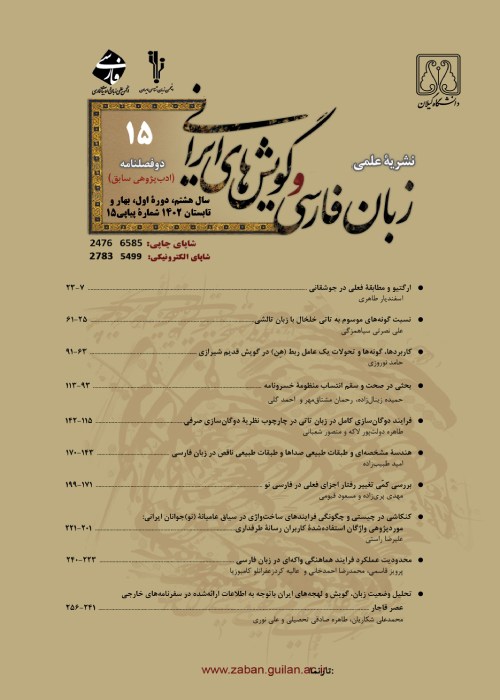The role of Quantifiers in Relative Clause Occurrence in Spoken Persian
In addition to the grammatical weight and the nominal head thematic role effects on the processing of a relative clause, which has been dealt with extensively in previous studies, other factors influence the processing of the relative clause. In the present paper, the research data has been collected from TV and radio programs and the quantifier's role on relative clauses occurrence has been investigated based on Wiechmann approaches (2015). Wiechmann believes that each component in a relative construction can affect other components occurrence. Results show that ambiguity and generality in the meaning of the modified head, and occurring in special constructions affect the relative clause presence. This is compatible with exemplar–based theory in that components of a structure affect each other's occurrence. The result of this study can be used in determining the degree of ambiguity among Persian quantifiers and can explain how relative clauses are processed.
A relative clause is a construction consisting of a nominal and a subordinate clause attributively modifying it. The nominal is called the head and the subordinate clause is called relative clause (henceforth RC). The attributive relation between head and RC is such that the head is involved in what is stated in the clause. As prenominal modifiers precede post modifiers, they can have certain influence on post- modifiers occurrence. It seems that indefinite pronouns occur with RCs more than any other prenominal modifier. Wiechmann believes that the more general the term, the greater the need (and hence the likelihood) for the additional material that enables the hearer to identify the intended referent of the complex. In this way, RC as a clausal post modifier is a good alternative for post modification of the expressions in the following list: anyone, anything, best everybody all, anybody, everybody, that thing, things, those, time, two, uncle, way, what, woman, women. Accordingly, in the present paper we are going to investigate the co-occurrence of quantifiers in expressions such as h{r ‘any , every’ k{s ‘one, body’ ; h{r ‘any , every’ ,tSiz ‘thing’,… and relative clauses in Persian.
In cognitive construction grammar, a relative clause is unified as a language sign which its processing procedure is highly the same as the lexicon’s. Linguistic signs are of different intermediate levels that have both fixed and variable parts. A complete characterization of a high level construction, such as an English RC, will have to take into account its constitutive constructions and their properties. That is to say, an actual utterance of an RC always instantiates a number of lower level construction simultaneously. Each grammatical unit is a routine process which speakers master it over repetition and they activate it as a predetermined assembly. Every experienced exemplar of an RC is involved in its cognitive representation. An exemplar-based representation indicates a list of words happening in a certain slot. When uttering a construction, we do not refer to a set of general features but analogically we refer to the memories of lexical items which have happened in that slot in previous exposures.
The present paper is a descriptive - analytical research about RC s in spoken Persian. We analyzed each quantifier co-occurrence with RC and other post modifiers. Data for the current paper has been collected from 30 hours of conversations on TV and radio programs. 1200 relative clauses were extracted in addition to 500 sentences with a nominal head modified by other post modifiers to find out the difference between relative clause and other post - nominal modifiers.
Prenominal modifiers behave differently in co-occurrence with RCs. The difference is displayed in the following hierarchy: h{r ‘every, any’ 90.21% > Xeili {z ‘many of’ 45.16% > h{me ‘all’ 30.20% > yeki{z ‘one of’ 27.88% > hitS ‘no none’ 21. 05% The results indicate that Persian quantifiers are of different characteristics. h{r ‘every, any’ refers to a singular head and it is used in conditional constructions to indicate general propositions. In fact, after some heads such as h{r k{s ‘every one, any one’, h{r tSiz ‘every thing, anything’ RC is more predictable to happen and easier to process. In the present paper, 3 constructions were introduced which included a nominal head modified with a quantifier: 1. RC construction with a nominal head modified with “h{r” implying a conditional proposition. h{r‘every, any’ + head + RC + MC. h{r k{s kar n{-kon-e be s{lam{ti=e Xod-eS asib mi- z{n-e. any one work (exercise) NEG- SUBJ. do- 3SG. to health =of self-3SG.CL damage PROG-PRES.hit. - 3SG. ‘Anyone who doesn’t exercise will damage his own health’ 2. An extraposed RC with some nominal head modified with quantifier Xeili {z ‘ many of ‘. in these constructions the verb is copular: Xeili {z pezeSk-a h{st-{n ?{sl{n did-e ne-mi-S-{n many of doctor-PL PRES.be- 3PL never see- PP. NEG- PRES- be- 3 PL ‘There are many doctors who are never seen’ 3. An extraposed RC with an indefinite quantifier hitS ‘ nothing’ According to exemplar-based theory, different components affect each other’s occurrence. Frequent use of these components leads to a pre-defined and entrenched construction which in turn increases RC usage in related contexts.
As indicated in section 4, we introduced some intermediate levels of RC in Persian. These findings are in line with exemplar theory principles. In exemplar theory, different components of a construction affect each other’s presence. Frequent occurrence of these components leads to construction entrenchment in the speaker’s mind helping to predict next construction components. The results also show that pre-nominal modifiers display three different behaviors in occurrence with RCs: 1. Compared to all other quantifiers, the quantifier h{r ‘any, every’ is more used with RC in a way that all the RC occurrence with other quantifiers is less than h{r ‘any, every’ occurrence with RC. 2. In Xeili {z ‘many of’ construction, RC is more frequently used compared to any of other post modifiers. 3. In hitS ‘no, none’ and yeki {z ‘one of’ constructions RC occurred less than other post modifiers such as genitive and descriptive modifiers. It is recommended that the co-occurrence of quantifiers with RC be investigated cognitively in language laboratories. Select Bibliography Bybee, J. 2013. Usage-based Theory and Exemplar Representations of Constructions, In: Thomas Hoffmann and Graeme Trousdale (eds.). TheOxford Handbook of Construction Grammar.,Oxford: Oxford University Press.
- حق عضویت دریافتی صرف حمایت از نشریات عضو و نگهداری، تکمیل و توسعه مگیران میشود.
- پرداخت حق اشتراک و دانلود مقالات اجازه بازنشر آن در سایر رسانههای چاپی و دیجیتال را به کاربر نمیدهد.



